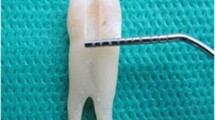Abstract.
Microleakage at the cervical tooth/restoration interface of class II restorations was evaluated, either on multiple sections or on teeth rendered transparent, in order to determine whether a modified clearing protocol could be established as a routine method for microleakage evaluation in class II restorations. Forty-eight class II cavities were restored with a composite/bonding agent (Tetric Universal/Heliobond, Vivadent, Schaan, Liechtenstein) in bulk technique (BT) (n=24) and with a composite/dentin adhesive system (Tetric Universal/Heliobond/Syntac Classic) in increments (IT) (n=24). The 24 specimens were assigned to two groups. Group I: dye penetration (India ink), multiple sectioning (conventional method). Group II: dye penetration (India ink) and modified clearing protocol. Linear microleakage (% dye/section) along the cervical tooth/restoration interface on multiple sections, and microleakage patterns (% dye/surface) at the cervical surface on transparent teeth were evaluated with an image analyzing system. The data were statistically analyzed with the Mann Whitney U-test, Wilcoxon's rank sum test, and the error rates method. The application of the modified clearing protocol allowed for distinct evaluation of microleakage patterns. Either protocol revealed lower penetration values for IT than for BT. With the conventional protocol, the median (25–75% percentiles) percentage of dye penetration was 2% (1–46%) for IT and 40% (23–85%) for BT. The clearing protocol revealed dye penetration of 5% (1–22%) for IT and 16% (4–24%) for BT. The clearing protocol together with the use of India ink as tracer allows for evaluation and visualization of the continuous distribution of microleakage at the cervical tooth/restoration interface without loss of information due to sectioning, although this method seems to be less discriminative than the conventional sectioning technique.
Similar content being viewed by others
Author information
Authors and Affiliations
Additional information
Electronic Publication
Rights and permissions
About this article
Cite this article
Federlin, M., Thonemann, B., Hiller, KA. et al. Microleakage in class II composite resin restorations: application of a clearing protocol. Clin Oral Invest 6, 84–91 (2002). https://doi.org/10.1007/s00784-002-0156-5
Received:
Accepted:
Published:
Issue Date:
DOI: https://doi.org/10.1007/s00784-002-0156-5




